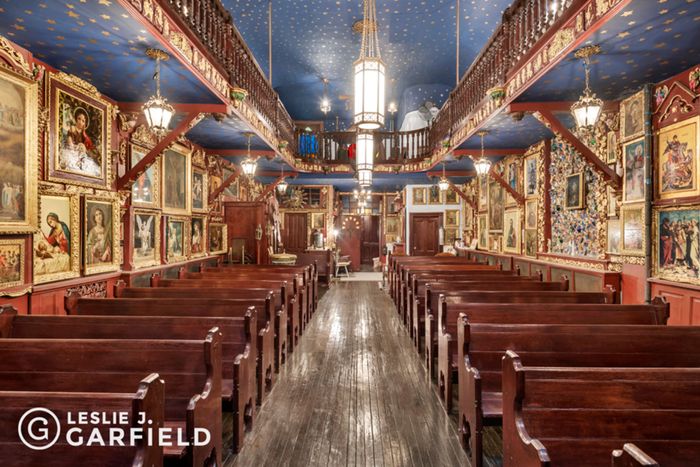
On East 4th Street, between the small P.S.15 Roberto Clemente School and a three-story brick townhouse, sits a church that, for the last 46 years, has been known as the San Isidoro y San Leandro Western Orthodox Catholic Church of the Hispanic Mozarabic Rite. Its façade is unusual: Gothic Revival, with eight pointed arched windows (all of which have alternating blocks of white and brown voussoirs), intricate double wooden doors with brass details, and a steeply pitched roofline. Inside, meanwhile, things are fantastically maximalist: Practically every surface of its 74-foot-long sanctuary and chancel is covered in gilded icons and ornaments, geometric stained glass, and tiny figurines. Looking at pictures of the place — of which there are currently many, since it is up for sale and for lease — one is left with many questions. Like: Who built this place? Is it landmarked? Are those 3-D mosaics on the wall? Could someone use this as a residence? We decided to tackle all of these, and more.
How old is this building?
About 130 years. It was built in 1892 for the Church of St. Elizabeth of Hungary, which served the Slovak and Hungarian immigrant communities. In 1918, the building became a Russian Orthodox Church (the white-painted wrought iron entrance gate still has a crest with a double-headed eagle), and finally in 1975, a Western Orthodox Catholic Church that sought to practice Mozarabic liturgy, which was used by Christian communities living under Arab rule in early-Medieval Iberia (now Spain and Portugal). The Mozarabic Rite, also called the Hispanic Rite, is extremely uncommon outside of Spain. We only found one other place of worship in the New York metro area that identified as the Hispanic Rite: the St. Eulalia Orthodox Mission Chapel in Yonkers, whose website has not been updated since 2012.
Who owns it now?
The nephew of Patricio Cubillos-Murillo, the original founder of the church in its current form, who passed away years ago.
What’s going on in the sanctuary?
A lot. The main level has a 30-foot ceiling with a huge skylight. As you can see in the photo above, there’s an 800-square-foot U-shaped mezzanine (originally built for the choir, per a previous listing), with carved banisters and a gilded base around the entire perimeter. The coved ceiling, as well as the underside of the mezzanine, were hand-painted in blue with gold stars all over. There is diagonal bracing (painted in red with gilded embellishments) under the mezzanine along the two rows of pews. There are six large hexagonal Gothic pendant light fixtures lining the aisle, plus ten smaller pendants hanging over the pews and ten more small cast-iron light fixtures (and one especially swirly chandelier) in the altar area.
What about the stuff on the walls?
In addition to dozens upon dozens of gilded framed icons, a few spots on the wall also have large 3-D mosaics in which colorful tile is mixed in with tons of tiny figurines, often of angel heads. (There’s also a similar but much larger mosaic wall hidden on the rear exterior of the building). You’ll spot more angel figurines tucked along the edge of the ledge in the altar area (seen in the photo below), above at least 14 red columns wrapped in gilded flowers and leaves. (The altar area is also packed with artworks; we counted at least 50 in that space alone).
Is this place landmarked?
No, but people have tried. When the property went up for sale in 2017, Village Preservation, the local historic preservation group, submitted a request for individual landmark designation to the Landmarks Preservation Commission. The proposal was denied. (By the way, individual landmark designations only apply to the exterior, so all the stuff going on inside the church was not considered). While it did not get landmarked, the building has probably lasted longer than many locals have expected. The property was originally listed for $6 million in 2017, and then re-listed for $5.5 million in 2018, and is now listed for $5 million.
Is anything still happening there?
No regular congregation or services were ever established at the church. Someone who claims to have lived next door for 30 years (and commented so on this video of the church from 2007) says the building was open for a few short years in the 2000s for private prayer and meditation and special services (a commenter on EV Griege also mentions wedding and baptism ceremonies were held there around that time period). Beyond that, the church was also known for holding frequent rummage sales (there are photos from one such event in 2010 from EV Grieve, who reported buying records for ten cents each).
Could you actually live in it?
You could. There’s an apartment above the sanctuary with a living room (as seen above), dining room, two decent-size bedrooms, a bathroom, walk-in closet, another bonus windowed room, and a spacious (but pretty decrepit) kitchen with a door out to a roughly 800-square-foot roof terrace with three church bells on the rear side. There’s also a functioning cylindrical wood-burning stove and at least five gothic chandeliers. This space is just a flight of stairs from the mezzanine.
Who might actually end up moving?
Some sort of arts organization probably. “While there might not be great chances of it continuing as a house of worship, one would hope that a smart buyer would say this is a great spot for some other form of gathering,” says Andrew Berman, executive director of Village Preservation. “Hopefully as we recover from the pandemic, there’s a huge appetite for venues like theaters.” On the other hand, if the building is sold and demolished, whatever springs up could be quite a bit bigger than before. The property comes with an additional 4,700 square feet in unused air rights, which means the owner would be free to build up a couple of more floors or start over with a taller structure totaling a maximum of roughly 9,230 square feet above ground.








